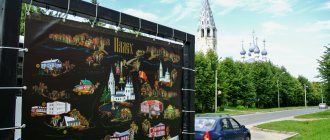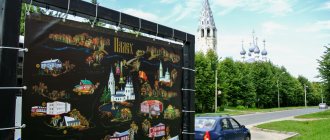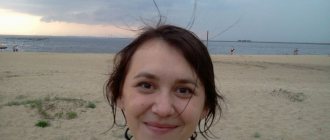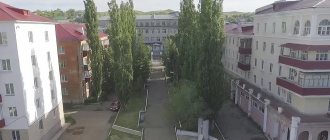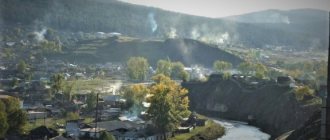Maloarkhangelsk: attractions, photos, videos, reviews | Guide to Russia
A quiet town with picturesque surroundings and a beautiful Victory Park. Along the edges of the alleys there are busts of soldiers, natives of Maloarkhangelsk, who died during the Great Patriotic War. There is also a monument here - a 57-mm ZIS-2 anti-tank gun.
Museum of Military and Labor Glory on Karl Marx Street - a significant part of its exhibition is dedicated to the battles that were fought near Maloarkhangelsk in the 1940s, and to the city residents who took part in them.
In Maloarkhangelsk you can visit the Church of Michael the Archangel, which was built in 2005.
One of the most picturesque places near Maloarkhangelsk is a small forest park 8 km from the city, which locals call “Granitsa”, since the forest is located between Maloarkhangelsk and Glazunovsky districts of the Oryol region. The well-groomed and clean park is equipped with gazebos. At the opposite end of the city there is another local attraction - St. Andrew's Holy Spring with crystal clear water.
A little further from Maloarkhangelsk, near the village of Zelenaya Roshcha, there is a large forest plantation - the Murashikha tract. Almost centuries-old lindens, aspens, pines grow here, jays, goshawks, whirligigs, spotted woodpeckers and many other birds are found. Another natural monument is located in the suburban village of Lukovets, which is reached by buses from the city. Here groundwater comes to the surface - four springs.
What to bring from Maloarkhangelsk
There is a large clay quarry near Maloarkhangelsk, so the production of ceramics and clay toys was developed in the city. Now the local school for making utensils from clay is being revived, so buying a clay toy in the city is quite possible.
The village of Arkhangelskoye, on the site of present-day Maloarkhangelsk, was founded in 1778. In 1796, the settlement received the name Maly Arkhangelsk City, later the city began to be called Maloarkhangelsk.
By the way, in Russia there are three settlements whose names include Arkhangelsk. In addition to Arkhangelsk itself and Maloarkhangelsk in the Oryol region, there is also the village of Maloarkhangelsk in the Chita region.
strana.ru
Literature
- Vasily AGOSHKOV. MALOARKHANGELSKY SOURCES. Historical and literary local history publication. Reader for university students. 440s. Orel-Maloarkhangelsk, 1999
- Book 1. Small Arkhangelsk city. Pages 3-278
- Book 2. Little Arkhangelsk freedom. Pages 279–440
- MALOARKHANGELSKY LOAF. Editors-compilers Pyotr ZALOZHNYH and Vasily AGOSHKOV. Collection of works by Little Arkhangelsk poets and prose writers... 80 p. Orel-Maloarkhangelsk, 1999
- Vasily AGOSHKOV. Why are the regional centers of the Oryol region named this way? Among them is the city of Maloarkhangelsk. 64с, Orel, 1999
- Victor Kuzmich VNUKOV. “I WILL NOT LEAVE MY FATHER’S BOARDS!” A book of poems and memories about the poet. To the 80th anniversary of the poet. 128 pp.
- Nikolai TETEREV. MALOARKHANGELSKOY UNDERGROUND. 196 pages. The author of the idea is V.I. Agoshkov. SPONSORS: Family and O. V. Panteleev. The city of Novomoskovsk, Tula region. N. TETEREV is also the author of the books: “On the Verge of Death” and “In the City of My Youth.”
Sights and interesting facts about Maloarkhangelsk
Maloarkhangelsk is a city (since 1778) in the Oryol region of Russia, the administrative center of the Maloarkhangelsk district forms the urban settlement “City…
Maloarkhangelsk is a city (since 1778) in the Oryol region of Russia, the administrative center of the Maloarkhangelsk district, forms the urban settlement "City of Maloarkhangelsk". Population - people. ().Zmіst1 Geography2 History3 Population4 Economy5 Famous natives6 Notes7 LinksGeographyThe city is located 82 km south of Orel, 14 km from the railway station of the same name. History Maloarkhangelsk was founded in 1778 as a district town of Maloarkhangelsk district of the Oryol governorship (since 1796 - Oryol province) from the village of Arkhangelskoye, known since the 17th century. The definition of “small” was given to distinguish it from the city of Arkhangelsk, which at that time was usually called “Arkhangelsk City”. Over time, the form Maloarkhangelsk becomes firmly established in use. Since 1928, the city has been the center of the Maloarkhangelsk district of the Oryol district of the Central Black Earth Region (since 1937, part of the Oryol region). During the Great Patriotic War, the city was occupied by German troops in October 1941. Liberated on February 23, 1943 during the Maloarkhangelsk operation. Since January 1, 2006, the city forms the urban settlement “City of Maloarkhangelsk”. Population One of the smallest cities in Russia: as of January 1, 2014, it is in 1083rd place out of 1,100 cities of the Russian Federation. Economy The center of an agricultural region. Factories: experimental machine-building plant, butter factory, bakery plant, meat processing plant. Famous natives Tsvetaev, Vyacheslav Dmitrievich (1893-1950) - Soviet military leader, Hero of the Soviet Union, Colonel General. Notes Links Official website of the district History of the coat of arms of Maloarkhangelsk Maloarkhangelsk in the encyclopedia "My City" Category: Cities of the Oryol region Category: District centers of the Oryol region Category: Cities of Russia with a population of less than 10,000 inhabitants Category: Settlements of the Maloarkhangelsk region
www.keeptravel.com
Physiographic characteristics
The southernmost city in the region, located on the Central Russian Upland in the center of the East European Plain, 81 km southeast of Orel and 14 km east of the railway station of the same name.
Time
Maloarkhangelsk, like the entire Oryol region, is located in the MSC time zone (Moscow time). The applied time offset relative to UTC is +3:00[5].
Climate
The city is located in the temperate continental climate zone (according to the Köppen classification - Dfb
). Winters are moderately cool, summers are unstable.
The main attractions of Maloarkhangelsk
Every person, when planning a trip, prepares for himself a list of attractions in Maloarkhangelsk that are a must-see. Some plan individual routes to explore the city, others order special sightseeing tourist programs. Traditionally, they cover the main attractions of Maloarkhangelsk and introduce tourists to the main milestones of the history and cultural life of the city.
Connoisseurs of creativity first of all note the sculptural attractions on the map of Maloarkhangelsk. In large city squares you can most often visit iconic monuments with which all tourists take photographs. But in popular public gardens you can visit exhibitions of ultra-modern sculptural compositions and installations. They are made from the most unconventional materials and have amazing shapes that you will need to think about more.
Religious sites stand out among the main attractions of Maloarkhangelsk. They are an integral part of the appearance of the Russian city; most of them have survived significant religious and historical events. In Maloarkhangelsk and outside the city, you can visit monasteries known throughout the country, admire the elegant appearance of iconic Christian churches, or go into cozy and miniature chapels, so popular among local residents.
While touring the area, you can also see non-traditional religious sites. These could be national religious sites, ancient religious buildings, or generally mysterious places of power.
Walking around Maloarkhangelsk is especially romantic. You can first get a map of Maloarkhangelsk with attractions and routes, or just wander where you like. In this case, it will be even more exciting. Give yourself the chance to get lost in the colorful streets or wander around the parks. And if you get tired, you can have lunch or drink coffee in some nice cafeteria. By the way, in Maloarkhangelsk there are a couple of famous places that every guest of the city wants to visit.
If you want to thoroughly study the historical past and modern life of the city, come on an excursion to the museum institutions of Maloarkhangelsk. They store extensive collections on ethnology, art, folk arts and crafts, from archaeological excavations. Traditionally, these attractions are located in the center.
At the same time, thematic open-air museums can often be found outside the city. They present fascinating exhibitions dedicated to national life and folk crafts. These can also be installations of ancient settlements or protective forts. Similar attractions of Maloarkhangelsk will be interesting for children.
For tourists traveling with families, the main question is always on the agenda: where to go with children. The most popular offer is to go to one of the water entertainment centers of Maloarkhangelsk. Most often, there are discounts when ordering a family day pass.
If you are going on vacation in winter or spring, we recommend considering the ski centers of Maloarkhangelsk for a fun pastime. There are a lot of activities for visitors of all ages: various ski and snowboard slopes, cheesecake skiing, interesting extreme parks for the pros. Usually these complexes are located near the city. In this regard, it is more comfortable to arrive at the place by your own car or rent a car.
An excellent prospect for family vacations is a trip to nature. Natural attractions are located near Maloarkhangelsk. These could be rivers, gorges, popular nature reserves. You just need to choose a place. You can get to these natural attractions either on your own or using the services of public transport. Find out in advance the schedule of minibuses running from suburban bus stations in the direction that suits you. On such a trip you will get a lot of pleasant emotions from being in nature and restore your moral and physical strength.
If you arrived in the city on work matters, then you do not have free time for long excursion trips. In this case, it would be a good idea to choose a condensed guide to the sights of Maloarkhangelsk with photos and descriptions.
You can always find such a guide after arriving in the city at souvenir kiosks at railway stations or at the air terminal. This guide contains a list of the most iconic places to go in Maloarkhangelsk, with names and photos of attractions. Agree, this greatly simplifies the task of what to see in Maloarkhangelsk, especially if you have little time.
But, if the directory includes the most visited places in Maloarkhangelsk, then in the search network you can see a list of new, but no less interesting attractions with reviews from experienced travelers. Abandoned mines, mysterious quarries, unusual narrow-gauge railways, overpasses - these attractions attract adventure seekers.
When planning a trip to Maloarkhangelsk, we recommend studying information not only about the attractions, but also about other important city sites. To move around the city, it is worth knowing the traffic pattern of public transport, the localization of the main railway and bus terminals or river stations, metro stations. At the same time, such important public buildings in Maloarkhangelsk can be very interesting from a tourist point of view. Often they are the ones who form the first impression of a locality on a visitor’s part.
Show more
akuaku.ru
Folk attractions of Maloarkhangelsk: “Border”
Home » Attractions, Culture 12 November 2009 No comments
City attractions of all places without exception can be divided into documented ones, about which a lot is written and talked about, and undocumented, folk ones. Folk attractions mostly include places associated with some regularly repeated event, such as weddings. It is known that in every city the wedding cortege moves along the same route over and over again, following a tradition established by someone unknown. In Maloarkhangelsk, after the ceremonial laying of flowers in Victory Park, it is customary to go “out into nature.” Nature most often serves as a special place on the border between Maloarkhangelsk and Glazunovsky districts. The place is called among itself - “The Border”.
This border is located 8 km from Maloarkhangelsk on the Orel-Kolpny highway and is a birch planting. The place is cozy, quiet, protected from the wind, birch trees are good at any time of the year, and the drive is 7 minutes. Over time, they began to come here without any wedding occasions: for birthdays, on professional holidays, just like that. With the help of the city, the place was landscaped: a gazebo was erected, trash cans were installed, a parking area and a section of the path deep into the planting were paved.
There is another gazebo at the other end of the Maloarkhangelsk district: on the border of the same road with the Kolpnyansky district. But it takes longer to get there, and there are no such wonderful birches nearby. They stop there for a short time, passing by the St. Andrew’s Well (another name is St. Andrew’s Holy Spring), which, although it belongs to the Kolpnyansky district, is considered its own. St. Andrew's Well is also included in the newlyweds' itinerary wish list; it will be discussed separately.
Related Posts
maloarhangelsk.ru
Photo of old Maloarkhangelsk
Old photographs of old Maloarkhangelsk. If you can clarify the year, feel free to write it in the comment (reasonably), indicating the caption for the photo.
Maloarkhangelsk Secondary School, old photo.
Star ski relay. 03/15/1948.
Maloarkhangelsk rallies and demonstrations over the years
Demonstration on November 7. School is underway (teachers).
Demonstration in Maloarkhangelsk. In the background is a pharmacy (area of the Kolos k/t, now a residential building).
Rally in Maloarkhangelsk, old photo.
A rally in Maloarkhangelsk at the monument to V.I. Lenin (Lenin Square).
Monument to V.I. Lenin in Maloarkhangelsk
About the monument here.
Laying the foundation stone for the monument to V.I. Lenin.
A rally in Maloarkhangelsk at the monument to V.I. Lenin (Lenin Square).
Rally at the monument to V.I. Lenin.
City square of Maloarkhangelsk and monument to Soviet soldiers
Entrance to the city square.
A rally in the city park near the monument to Soviet Soldiers.
City square. Monument to Soviet Soldiers.
A rally in the city park near the monument to Soviet Soldiers. In the background is a destroyed building - now the federal court, formerly the Republic of Komsomol.
Annual agricultural exhibition in Maloarkhangelsk
The annual agricultural exhibition in Maloarkhangelsk was located on the site of the current bazaar. Entrance.
At the annual All-Russian Agricultural Exhibition in Maloarkhangelsk, each collective farm had its own tent.
Participants of the All-Union Agricultural Exhibition who deserved All-Union Agricultural Exhibition medals. From left to right: Galina Razinkova, Tamara Petrova, Valya Petelina (1957). Read about the Razinkovs here and here.
Participants of the All-Russian Agricultural Exhibition in Maloarkhangelsk.
Photos selected and scanned by Masha Nikitushkina and Dasha Olgina. From the private archive of Galina Ivanovna Svetlykh.
Related Posts
maloarhangelsk.ru
Notable natives
- Alisov, Boris Pavlovich - Soviet climatologist.
- Kokuev, Nikita Rafailovich - Russian entomologist.
- Kochukov, Nikolai Sergeevich - Soviet and Russian sculptor.
- Kuleshov, Pavel Nikolaevich - Russian scientist and livestock breeder.
- Morozov, Sergei Sergeevich - Soviet geological engineer, soil scientist, soil scientist, geographer.
- Obolensky, Leonid Egorovich - Russian writer, poet, philosopher and publicist, critic, publisher.
- Tsvetaev, Vyacheslav Dmitrievich - Soviet military leader, Hero of the Soviet Union.
Geography and nature of Maloarkhangelsk region
Position
Maloarkhangelsk district is located in the center of the Central Russian Upland, on the East European Plain.
The length of the region from west to east and from north to south is approximately 60 kilometers.
The total area of the district is 754 sq. km.
The total population is 14.7 thousand people *.
The regional center is the city of Maloarkhangelsk. Located at a distance of 14 kilometers from the railway station of the same name. The city has a population of 4.2 thousand people.
Administratively, the district is divided into 8 municipalities: the city of Maloarkhangelsk and 7 rural councils. There are 91 settlements.
Borders
Maloarkhangelsk district borders in the north with Sverdlovsk, in the northeast with Pokrovsky, in the east and southeast with Kolpnyansky, in the west with Glazunovsky districts of the Oryol region; in the south - with the Kursk region.
The regional center - Maloarkhangelsk - is located at a distance of 14 km from the railway station of the same name. From Maloarkhangelsk to urban settlement Ponyri - the center of the Pokrovsky district of the Kursk region - 14 km, the same distance from Maloarkhangelsk to the urban settlement. Glazunovka.
Administratively, the district is divided into 8 municipalities: the city of Maloarkhangelsk and 7 rural settlements. There are 91 settlements.
Roads
Until recently, the Maloarkhangelsk region was compared to “appendicitis”: apparently, due to its remoteness from Orel and the enclosed territory.
To get from Maloarkhangelsk to other areas it was necessary to make a big “detour” through Zmievka, and from there to Pokrovskoye, Droskov, Kolpny. The asphalting of the Maloarkhangelsk-Kolpny route made it possible to launch regular buses along the Orel-Maloarkhangelsk-Kolpny-Dolgoe route.
The roads from Maloarkhangelsk to the main settlements of the region have been paved.
Transport
The transport network of the region is represented by the Maloarkhangelsk section of the railway and roads with a length of 154 km.
Transport services are provided by a motor transport company, which fully meets the need for passenger transportation. Regular bus service has been organized with the regional center, Maloarkhangelsk station, and with all central estates. For many years, the work of motor transport has been headed by Yu.Ya. Surkov.
Springs
Natural monument of regional significance “Springs of the village of Lukovets”.
Location: Oryol region, Maloarkhangelsk district, village. Lukovets, right bank of the Sosna River. It occupies an area of 1.0 hectares. Registered by the Oryol Regional Committee of Ecology and Natural Resources, the administration of the Maloarkhangelsk District. The hydrological natural monument “Springs of the village of Lukovets” is an outcrop of two types of groundwater on the bank of the Sosna River in the village. Onion.
Groundwater of the first type is represented by four powerful springs gushing from Devonian limestone deposits. Water falls from a meter height, forming several waterfalls.
The first source is located at the bottom of the ravine, three more are 2 meters downstream of the river. The water in the springs is clear and has no foreign tastes or odors. At the place where water falls from the third spring, a spring gushes out from under the stones. This is the exit to the surface of the second type of water. The water in the spring is clear, yellowish in color, has a ferruginous taste, and this differs sharply from the water located above the springs. Streams of water from springs flow down rocky beds into the Sosna River.
Hydrological natural monument “Springs of the village of Lukovets” - photographs.
The legend of the Holy Well in the village of Podkopaevo.
“At the turn of the 19th - 20th centuries, for three years in a row on the Ninth Friday (counting from Easter), a strong hailstorm knocked out all the vegetation in Podkopaevo. This usually happened in July, when everything was blooming and fragrant. On the initiative of the Demyanov brothers - Ivan and Gavrila Ignatievich, wealthy Podkopayev residents - it was decided in the community to build a chapel on the highest place in the village, where there was a spring.”
Page dedicated to the Podkopayevsky holy well.
Ponds
Maloarkhangelsk district is famous for its wonderful ponds, of which there are more than a hundred. They were built by agricultural enterprises, as well as on the initiative of nature lovers.
There are probably no such beautiful ponds as in the Maloarkhangelsk region anywhere else. Many of them start from the upper reaches of rivers, and therefore the water in them is clean. For a long time, the dam for the pond on the Kulikov Rzhavets River was not restored. The district administration, with the support of the chief ecologist of the region, who has repeatedly won prizes in the region for nature conservation, V.I. Groshilin, erected a new dam. The beautiful pond not only brings joy to the residents of Maloarkhangelsk, but also creates a special climate.
The mirror area of Progressovsky Pond is 47 hectares, Velorovsky Pond is more than 25 hectares, Belenky Pond (old and new) is about 30 hectares. The ponds created on the Suchya River and its tributaries are beautiful. There are dams that were created back in the days of landowners who knew how to choose picturesque estates for themselves.
There is a place in our area from where water flows into the Volga, Don and Dnieper. This point is located just east of the Maloarkhangelsk station.
It is from here that the rivers Ochka (flows into the Oka and Volga), Snova (flows into Tuskar, Seim, Dnieper), and the Suchya River (flows into Sosna and Don) begin. In the northeast the Neruch River flows its waters.
Photos of ponds in the Maloarkhangelsk district of the Oryol region with a brief description.
Forests
The area is not rich in forests.
Not so long ago, only 2.9% of the territory was covered with green spaces.
In 1995, the regional committee for environmental protection, with the support of the Russian representative office of the World Wildlife Fund, gave the area the opportunity to plant 10 hectares of forest at the expense of the fund and using the technology developed by it. The forest has been planted. In recent years, 157 hectares of green space have been added to the area. Now young forests are gaining strength. Among them is a 21st century park, which has become an integral part of the green zone of the district center.
The pine, spruce, linden, rowan, and birch trees on the land of the Podgorodnensky and Progress agricultural enterprises and the TNV Lenin's Testament are pleasing to the eye. In total, the area under forests in the region has doubled in recent years.
The “Green Program” implemented by the district administration is being understood by the population; people are responding to the call to go out on an environmental clean-up day to develop springs, clean the bottom of a pond restored by an initiative method, clear the edge of a forest, etc.
There are 5 natural monuments in the area. Three forest ones: the Murashikha tract, “Dubrava”, Stone Heath, classified as the forest-park part of the forest-steppe zone with plants and animals rare for our places; natural and historical park of Baron I.A. Vrevsky, hydrological reserve.
More than 100 hectares of plantings in the Murashikha forest tract reach 80 years of age, while the total area of the tract is 322.0 hectares.
The Dubrava tract is distinguished by a close combination of forest and marsh vegetation, which serves as an ideal habitat and breeding place for wild animals - elk, wild boar, roe deer, martens, ermines and birds: gray heron, ducks, vulture hawks.
The “Stone Heath” tract is characterized by 30-year-old pine plantations, rare for the forest-steppe zone.
The territory of forest tracts is included in the species reserve for the protection of ungulates.
* Data from 2004
Related Posts
maloarhangelsk.ru
Notes
- ↑ 12
Oryol Region. The total area of land of the municipality. FSGS. - ↑ 123
The permanent population of the Russian Federation by municipalities as of January 1, 2022 (Russian). Retrieved April 27, 2022. Archived May 2, 2022. - THE USSR. Administrative-territorial division of the union republics on January 1, 1980 / Comp. V. A. Dudarev, N. A. Evseeva. - M.: Izvestia, 1980. - 702 p. — P. 192.
- Law of the Oryol Region of August 12, 2004 No. 414-OZ “On the status, borders and administrative centers of municipalities in the Maloarkhangelsk district of the Oryol region”
- Federal Law of 06/03/2011 No. 107-FZ “On the calculation of time”, Article 5 (undefined)
(June 3, 2011). - Streets of the city of Maloarkhangelsk (unspecified)
. - ↑ 1 2
Information on the website of the regional administration
(unspecified)
. Archived from the original on August 23, 2011. - ↑ 1 2 3 4 5 6 7 8 9 10 11 12 13 14
People's Encyclopedia “My City”.
Maloarkhangelsk (Oryol region) (unspecified)
. Retrieved June 18, 2014. Archived June 18, 2014. - The first general census of the Russian Empire in 1897. Novgorod province (undefined)
. Retrieved July 1, 2014. Archived July 1, 2014. - All-Union Population Census of 1926. M.: Publication of the Central Statistical Office of the USSR, 1928. Volume 9. Table I. Populated areas. Current urban and rural population (undefined)
. Date of access: February 7, 2015. Archived February 7, 2015. - All-Union Population Census of 1939. The size of the urban population of the USSR by urban settlements and intra-city areas (unspecified)
. Retrieved November 30, 2013. Archived November 30, 2013. - All-Union Population Census of 1959. The size of the urban population of the RSFSR, its territorial units, urban settlements and urban areas by gender (Russian). Demoscope Weekly. Access date: September 25, 2013. Archived April 28, 2013.
- All-Union Population Census of 1970 The size of the urban population of the RSFSR, its territorial units, urban settlements and urban areas by gender. (Russian). Demoscope Weekly. Access date: September 25, 2013. Archived April 28, 2013.
- All-Union Population Census of 1979 The size of the urban population of the RSFSR, its territorial units, urban settlements and urban areas by gender. (Russian). Demoscope Weekly. Access date: September 25, 2013. Archived April 28, 2013.
- All-Union population census of 1989. Urban population (undefined)
. Archived from the original on August 22, 2011. - All-Russian population census 2002. Volume. 1, table 4. Population of Russia, federal districts, constituent entities of the Russian Federation, districts, urban settlements, rural settlements - regional centers and rural settlements with a population of 3 thousand or more (unspecified)
. Archived from the original on February 3, 2012. - The size of the permanent population of the Russian Federation by cities, urban settlements and regions as of January 1, 2009 (unspecified)
. Retrieved January 2, 2014. Archived January 2, 2014. - All-Russian population census 2010. 7. Population of urban districts, municipal districts, urban and rural settlements, urban settlements, rural settlements of the Oryol region (undefined)
. Access date: February 1, 2014. Archived February 1, 2014. - Population of the Russian Federation by municipalities. Table 35. Estimated resident population as of January 1, 2012 (unspecified)
. Retrieved May 31, 2014. Archived May 31, 2014. - Population of the Russian Federation by municipalities as of January 1, 2013. - M.: Federal State Statistics Service Rosstat, 2013. - 528 p. (Table 33. Population of urban districts, municipal districts, urban and rural settlements, urban settlements, rural settlements) (undefined)
. Retrieved November 16, 2013. Archived November 16, 2013. - Table 33. Population of the Russian Federation by municipalities as of January 1, 2014 (unspecified)
. Access date: August 2, 2014. Archived August 2, 2014. - Population of the Russian Federation by municipalities as of January 1, 2015 (unspecified)
. Access date: August 6, 2015. Archived August 6, 2015. - Population of the Russian Federation by municipalities as of January 1, 2016 (Russian) (October 5, 2018). Retrieved May 15, 2022. Archived May 8, 2022.
- Population of the Russian Federation by municipalities as of January 1, 2022 (Russian) (July 31, 2017). Retrieved July 31, 2022. Archived July 31, 2022.
- Population of the Russian Federation by municipalities as of January 1, 2022 (Russian). Retrieved July 25, 2018. Archived July 26, 2022.
- Population of the Russian Federation by municipalities as of January 1, 2022 (Russian). Retrieved July 31, 2019. Archived May 2, 2022.
- Population of the Russian Federation by municipalities as of January 1, 2022 (Russian). Date accessed: October 17, 2022. Archived October 17, 2022.
- taking into account the cities of Crimea
- https://rosstat.gov.ru/storage/mediabank/bul_Chislen_nasel_MO-01-01-2021.rar Population of the Russian Federation by municipalities as of January 1, 2022 (1.85 Mb, 07/30/2021)
- Olga SUPONEVA |
Komsomolskaya Pravda website. “Turquoise Ring of Russia”: they plan to develop a new tourism brand in the Oryol region
(unspecified)
.
orel.kp.ru - Website of Komsomolskaya Pravda
(August 17, 2020). Access date: September 1, 2022.

